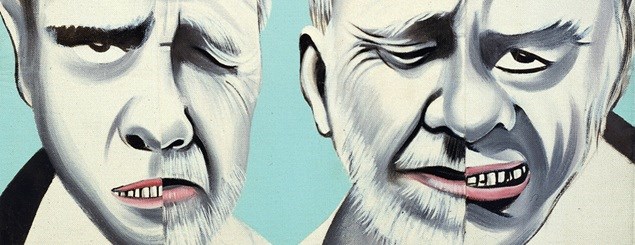ERRÓ'S MECHANICS
Erró is one of the most important artists of the 1960s' European avant-garde. His name is associated with the renewal of figurative painting through the invention of a narrative-critical collage-painting, as well as with happenings and experimental cinematography.
Open until december 30st.
Even though Erró has often been linked with artistic movements such as the Surrealists or Pop art he cannot be characterized as simply a member of one of these movements. Artistically, he is a free electron.
To Erró, creating art has, since the late 1950s, solely meant reusing existing material. Or as he modestly puts it: to make new out of old. He set off by combining collage with his own drawings but soon he only worked with photographical reproductions - as seen in the so-called mécacollages which mix mechanical objects and human anatomy. The illustrations used were found in cartoons, ads, posters and the like. Once finished, he projected the collage onto a canvas, painted an equivalent of the collage and obtained a smooth and concise style in his painting, resembling popular media. The collages can be seen as individual works of art, but they have primarily served as sketches for paintings.
A third dimension was soon added. The assemblages first occurred in Erró's series Mécamasks (1959) which consists of a number of masks made by second hand material or objects found in flea markets. The idea of the masks resembles that of the mécacollages and they were inspired by the sculptural works of the Cubists, the Surrealists, and the Dadaists. In 1962, Erró created assemblage props for Éric Duvivier's film Concerto mécanique pour la folie ou La Folle Mécamorphose. The film is about humans trying to cope in a futurist mechanical world and Erró created sculptures, reliefs and masks from industrial and urban waste and thereby masterly combined theme and technique.
A few years after Duvivier's film, Erró left the assemblage technique behind, only to return to it briefly in the late 1990s. In 1964, he bought a camera and started shooting his own short films - once again including the assemblages as props. The montages such as Méca-Make-Up (1965-67), Grimaces (1964-67) and Mary Monster (1967) were created by selecting, cutting, adding and gathering passages and clips of film, in which he thematically confronted human with mechanics and beauty with the monstrous.
The underlying idea and the coherence of Erró's works whether collage, assemblage or montage is thus consistent and obvious: By using old material in new ways he is teaching us to see anew, what we have already seen. And in the end, he is trying to change our view of the world.

